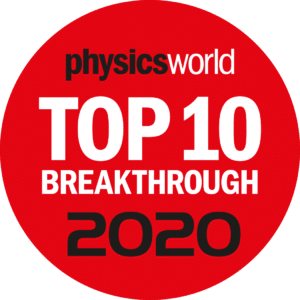Posted on December 15, 2020 in ASRC News, Photonics Initiative
The breakthrough provides a promising pathway for leapfrog advancement in imaging, optical-computing technologies, biosensing and more

The team employed “twistronics” (the science of layering and twisting two-dimensional materials to control their electrical properties) to manipulate the flow of light in extreme ways. Their findings, published in the journal Nature, hold the promise for leapfrog advances in a variety of light-driven technologies, including nano-imaging devices; high-speed, low-energy optical computers; and biosensors.
“We’re truly honored to be among this outstanding list acknowledged by Physics World for the most impactful research in physics for 2020” said Alù. “Our work has truly opened a new direction in nano-optics, with implications for materials science, imaging, sensing, computing and more. We are very proud of this recognition and very excited by the next steps in our research in this area.”
The 10 breakthroughs were selected by a team of five Physics World editors, who sifted through hundreds of research updates published on the website this year. In addition to having been reported in Physics World in 2020, the selections met several additional criteria, including being:
- A significant advance in knowledge or understanding
- An important work for scientific progress and/or development of real-world applications
- Of general interest to Physics World readers
For their work expanding the use of twistronics to photons, Alù and his collaborators took inspiration from the recent discovery of superconductivity in a pair of stacked graphene layers that were rotated to the “magic twist angle” of 1.1 degrees. In this configuration, electrons flow with no resistance. Separately, each graphene layer shows no special electrical properties. The discovery has shown how the careful control of rotational symmetries can unveil unexpected material responses.
The research team discovered that an analogous principle can be applied to manipulate light in highly unusual ways. At a specific rotation angle between two ultrathin layers of molybdenum trioxide, the researchers were able to prevent optical diffraction and enable robust light propagation in a tightly focused beam at desired wavelengths.
Typically, light radiated from a small emitter placed over a flat surface expands away in circles very much like the waves excited by a stone that falls into a pond. In their experiments, the researchers stacked two thin sheets of molybdenum trioxide — a material typically used in chemical processes — and rotated one of the layers with respect to the other. When the materials were excited by a tiny optical emitter, they observed widely controllable light emission over the surface as the rotation angle was varied. In particular, they showed that at the photonic magic twist angle the configured bilayer supports robust, diffraction-free light propagation in tightly focused channel beams that can be tuned over a wide range of wavelengths.
About the Advanced Science Research Center
The ASRC elevates scientific research and education at CUNY and beyond through initiatives in five distinctive, but increasingly interconnected disciplines: environmental sciences, nanoscience, neuroscience, photonics, and structural biology. The ASRC promotes a collaborative, interdisciplinary research culture with renowned researchers from each of the initiatives working side-by-side in the ASRC’s core facilities, sharing equipment that is among the most advanced available.
About The Graduate Center of The City University of New York
The Graduate Center of The City University of New York is a leader in public graduate education devoted to enhancing the public good through pioneering research, serious learning, and reasoned debate. The Graduate Center offers ambitious students more than 40 doctoral and master’s programs of the highest caliber, taught by top faculty from throughout CUNY — the world’s largest public urban university. Through its nearly 40 centers, institutes, and initiatives, The Graduate Center influences public policy and discourse and shapes innovation. The Graduate Center’s extensive public programs make it a home for culture and conversation.
